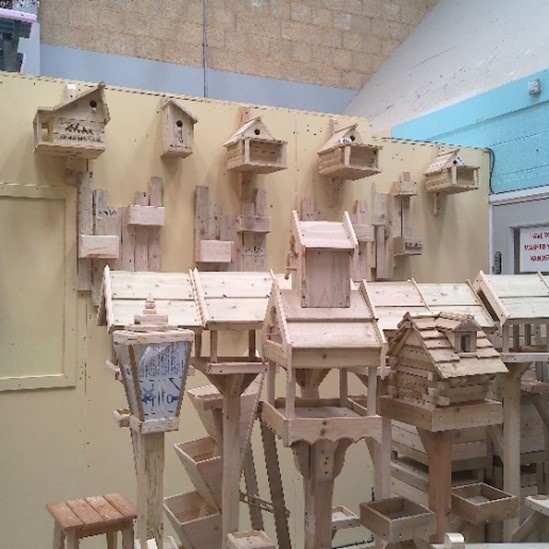What makes Oakwood so good?
Following a visit to the impressive Oakwood, Charlie Taylor discusses how strong leadership, high expectations of prisoners, and a culture of prisoner-led initiatives are at the heart of its achievements.
In April 2024 we began unannounced inspections of two prisons: HMP Wandsworth in London and HMP Oakwood, just north of Wolverhampton. The results could not have been more different. The situation at Wandsworth was so bad that I wrote immediately to the Secretary of State for Justice setting out my many concerns, while at Oakwood, we found a safe, productive jail where prisoners were falling over themselves to tell us how good it was.
How, at a time when so many prisons are in difficulties, has Oakwood become such a success?
Soon after it opened in 2012, it deteriorated so badly that prisoners began to name it Jokewood, but by the time we inspected in 2013, a new director, John McLaughlin, had begun to turn things round. With a tight budget and an inexperienced staff team he set about creating incentives that offered prisoners a clear path to a safer and more productive time in jail. Despite running one of the largest prisons in the country, holding over 2,000 men, he was well known by staff and prisoners alike, spending much of his time on the wings and, as a former professional snooker player, thrashing them every so often at pool. John moved on in 2021, but under his successor, Sean Oliver, the jail has continued to thrive.
At the heart of Oakwood’s success are the many prisoner-led initiatives – schemes generated and led by prisoners to help their fellow inmates to succeed. One prisoner, serving a life sentence, had set up a woodwork shop to support some of the most vulnerable prisoners. In other jails these men might have been bullied by their peers or even used as guinea pigs to test out new batches of Spice, but at Oakwood they were creating tables, bird boxes, benches and dog kennels that were bought by staff or sold to the public. What was most remarkable was that prisoners, using tools that could be easily have been seen as weapons, were working without the need for direct supervision from prison officers. Nearby, in an allotment and polytunnel, three prisoners proudly showed me the vegetables and herbs they were growing. Anywhere else, there would have been staff closely supervising them, but at Oakwood they worked alone. This market garden was right next to a fence over which contraband such as drugs or mobile phones could easily be thrown. I asked the men whether they had ever been approached by other prisoners to collect such packages and their resounding reply was that this was the best job they had had in years, and why would they want to risk it? They said that if anyone ever asked them, they would tell them to get lost.



From left to right: woodwork workshop, prisoners working in the gardens, peer-led resettlement advice
Not everyone at Oakwood behaves well, and those prisoners who get into trouble are not ignored but helped by fellow prisoners. Every day inmates trained as councillors meet and support their peers to get back onto the main residential units and into work. One explained to me that sometimes these men did not want to listen to staff, but prisoners could often get through to them.
Men also get help from their peers to settle in the jail when they arrive, and before release a prisoner-run resettlement team also provides useful information about where to get support, alongside more formal help from staff. The drug recovery wing, unlike many we see, is actually drug-free – prisoners, many of whom have dealt with addiction for years, are helped by their fellow inmates and the staff to give up the habit.
There is strong evidence that one of the best ways to stop reoffending on release is to maintain family ties, but all too often prisoners can struggle to maintain relationships while they are locked up, and can become estranged from their children. On the day I visited, Oakwood was running a dog visit day. Prisoners’ families were allowed to bring their well-behaved dogs into the jail to be reunited with their owners. Men could book individual rooms to host family visits – I saw children and parents sharing food on comfortable sofas, rather than sitting opposite each other in the type of restrictive visits hall we find in most jails.



From left to right: family cooking visit, outside visits space with animals, private ‘lounge’ visit room
Trust is at the heart of Oakwood’s success, and prisoners are given opportunities and freedoms that might frighten staff in other jails. But this trust is not just given out, it has to be earned. There are many incentives for doing the right thing at the prison, but those who break the rules are robustly dealt with. Risk is carefully managed and there is no sense that the prison is ‘soft‘; the expectations for prisoners’ behaviour are universally high, but prisoners who get into difficulties are given a way out and all around them they see the benefits of doing the right thing. Of course, things go wrong from time to time, but leaders have the confidence to accept that occasional failures are an inevitable consequence of innovation – you cannot have one without the other.
When I talked to director Sean Oliver about the prison’s success, he modestly put it down to having clear expectations of staff and prisoners, holding leaders to account and hard work. It sounds simple, but it is not easy.
When Oakwood was conceived, there was much public criticism about so-called titan prisons that would never work, but the prison has made a virtue of its size, carving out economies of scale and making good use of the limited space. Perhaps most surprising of all, in 2022–23 it cost less per prisoner, per year than any other jail in the country, at £17,006 compared with the category C average of £28,593 (costs-per-prisoner-individual-prison-2022-2023.ods (live.com)). It shows that cash is not everything.
Strong leadership and a culture that passes trust from the director to the leadership team, through prison officers, and down to the prisoners themselves have achieved impressive results at Oakwood. As a private jail, it has taken advantage of the freedoms that come with the contract, so it is easy to assume that the innovations at the prison could not be replicated in the public sector. It also has some advantages as a newer prison, yet it has been far better maintained than other prisons that are not much older. Like many other jails, it is a complex establishment holding a broad range of prisoners, from those serving short sentences to life, dealing with a significant throughput of men, 80% of whom are considered to be a high risk of harm to others. With courage and leadership, therefore, there is little at Oakwood that could not be achieved elsewhere.
Oakwood is the best prison I have seen in my time as Chief Inspector. I hope other governors and leaders in the prison service will be able to learn from its success.
